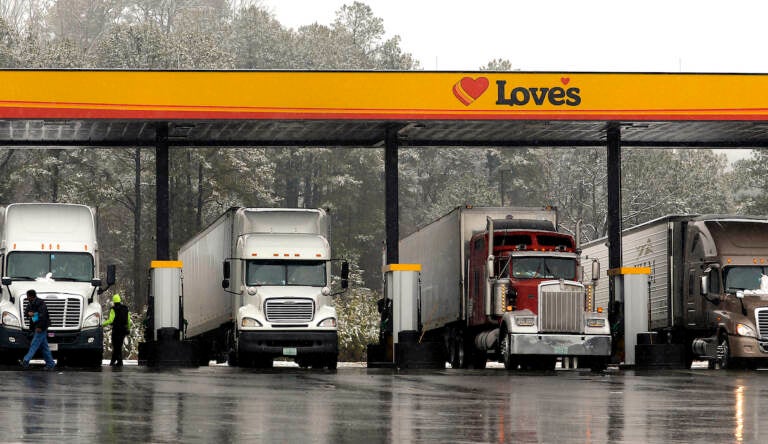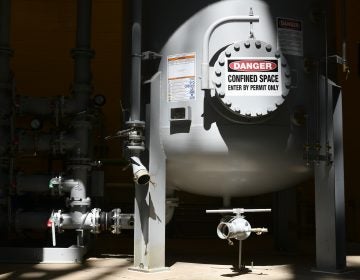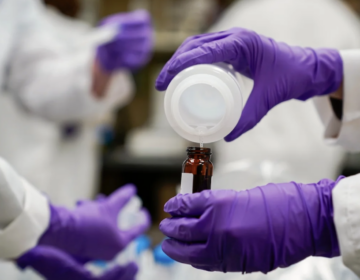EPA rule would make heavy trucks cut smog, soot pollution
The proposal would require the industry to cut smog-and-soot-forming nitrogen oxide emissions by up to 90% per truck over current standards by 2031.

FILE - In this Feb. 11, 2014, file photo, truck drivers stop at a gas station in Emerson, Ga., north of metro Atlanta, to fill up their tractor trailer rigs. A new government rule being announced by the Federal Motor Carrier Safety Administration on Thursday, Dec. 10, 2015, requires an estimated 3 million commercial truck and bus drivers to electronically record their hours behind the wheel in an effort to enforce regulations to prevent fatigue. (AP Photo/David Tulis, File)
The Biden administration is proposing stronger pollution regulations for new tractor-trailer rigs that would clean up smoky diesel engines and encourage new technologies during the next two decades.
The proposal released Monday by the Environmental Protection Agency would require the industry to cut smog-and-soot-forming nitrogen oxide emissions by up to 90% per truck over current standards by 2031. The emissions can cause respiratory problems in humans.
New rules would start in 2027 to limit the emissions from nearly 27 million heavy trucks and buses nationwide.
Although truck manufacturers are working on battery-electric and hydrogen fuel cell powertrains, the EPA says the proposal is not a zero-emissions truck requirement. Rather, the agency says there are pollution control devices in development that can keep diesels in use and still clean the air.
The EPA also is drawing up stronger limits for heat-trapping greenhouse gas emissions. Current standards would be updated starting in 2027 and stronger new standards would begin in 2030. Requirements were last updated in 2001, with the next big step coming in 2024.
The stronger new standards would not apply to old trucks, limiting the impact of the new rules.
Environmental groups praised the EPA’s action, but many urged the administration to move quickly on the proposal and then go farther toward requiring zero-emissions trucks.
“We really need to be doing both of these things simultaneously,” said Patricio Portillo, senior advocate for clean vehicles at the Natural Resources Defense Council. Portillo said he was disappointed that the EPA didn’t set requirements for hydrogen or electric truck sales as California and five other states now do.
He said the 90% reduction number sounds good, but still leaves a lot of pollution in the air. “The only way to get that out is to get to zero emissions,” he said.
Truck engine makers and other industry groups said they favor cutting pollution, but raised concerns that the requirements may not be technically possible or could make trucks costly and unreliable.
“We look forward to working with EPA to ensure that the final version of today’s rule is practical, technically feasible, cost-effective, and will result in the necessary fleet turnover to achieve the nation’s environmental objectives,” Truck and Engine Manufacturers Association President Jed Mandel said in a statement.
A group representing independent truckers said the EPA ignored input from drivers seeking practical emissions standards. The Owner Operator Independent Drivers Association called the requirements a “government overreach” that will force small-business truckers off the road due to the cost and reliability problems.
EPA officials say the new requirements comply with an executive order from President Joe Biden to clean up transportation, which is the leading source of greenhouse gas emissions nationwide. Transportation emits 29% of the gases, and heavy-duty trucks account for 23% of that. Biden is trying to cut greenhouse gas emissions in half by 2030 to battle the effects of climate change.
The new standards would bring widespread air quality improvements, particularly in areas already exposed to heavy truck traffic, officials say.
“Seventy-two million people are estimated to live near truck freight routes in America, and they are more likely to be people of color and those with lower incomes,” EPA Administrator Michael Regan said in a statement.
The agency says it will offer several options to reduce heavy truck and bus pollution, and it will take public comments into account before developing final standards by the end of this year.
“The EPA has engaged with stakeholders and identified several options in the proposal that address the robustness of the standards, timing for phasing in the standards, options to incentivize early clean technology adoption and improvements to emissions warranties,” the agency said in a statement.
The EPA also would tighten requirements for school buses, transit buses, commercial delivery trucks and short-haul tractors, areas where the shift to zero-emissions vehicles is farther along.
Early versions of fully electric semis are now going on sale, and the industry is testing trucks powered by hydrogen fuel cells that generate electricity.
The EPA says that new greenhouse gas standards could help hasten the transition to zero-emissions trucks and buses that weigh over 26,000 pounds.
Currently, battery electric trucks have limited travel ranges, and it takes a long time to recharge batteries. For hydrogen fuel cell trucks, there are few filling stations, and pollution is emitted when most hydrogen is made now from natural gas. But researchers are working on so-called “green hydrogen” that would be made using electricity from renewable sources such as wind or solar.
Under the pollution standards, manufacturers would be required to certify that their trucks meet the stricter requirements or face penalties. The EPA also wants them to lengthen the warranties on emissions controls, making them more cost effective for trucking companies to buy.
The new exhaust-treatment systems would come with a higher cost, as would the warranties, which likely would be passed along to truck and bus buyers. But the EPA says reduced pollution from the most stringent option would save the country up to $250 billion from 2027 through 2045, largely by preventing deaths and reducing health care costs.
The EPA said the stricter standards would prevent up to 2,100 premature deaths, cut hospital admissions and emergency room visits by 6,700 and prevent 18,000 cases of child asthma.

Get daily updates from WHYY News!
WHYY is your source for fact-based, in-depth journalism and information. As a nonprofit organization, we rely on financial support from readers like you. Please give today.






